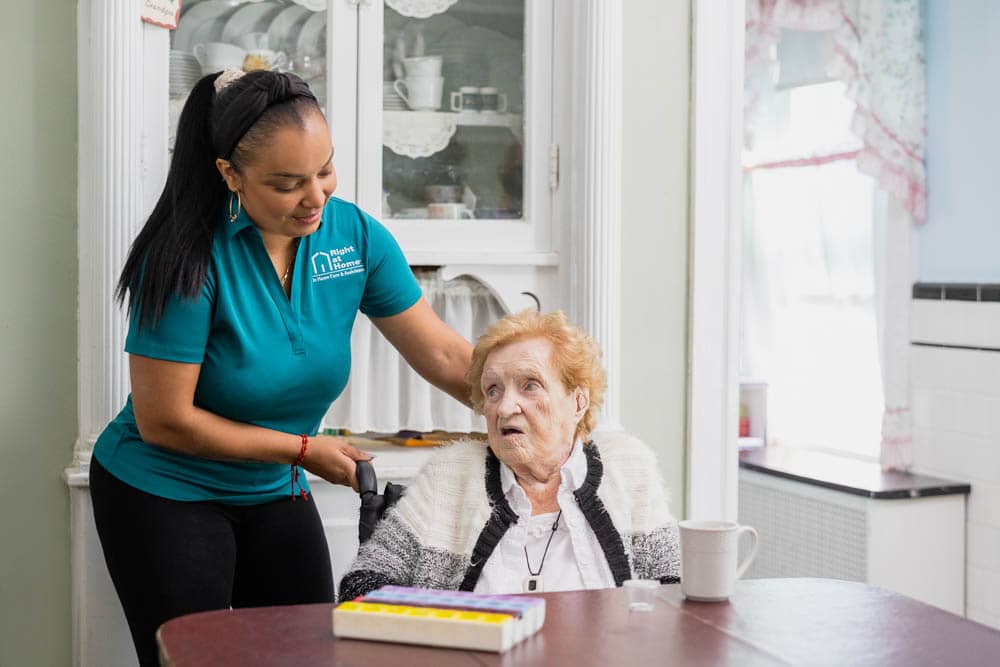

Paying for In-Home Care
Right at Home cares for thousands of families just like yours. We know that hiring an in-home care agency is one of the most important decisions you’ll make—you want to get it right and you have a lot of questions. One of the biggest questions is usually about the cost of in-home care services. Home care can be expensive, but there are a variety of options available to pay for ongoing care services for your loved ones.
Appalachian Council of Governments Family Caregiver Respite Program
This program provides family caregivers with a voucher for up to $1500 to be used for Right at Home Services. The funds must be used within 3 months.
- For a family caregiver caring for someone frail or disabled that is 60 or older or someone with dementia
- Needs based, not income based
- Eligible for 1 voucher every 12 months
- Call the Appalachian Council Family Caregiver Support Program at 864-242-9733 and leave a message for a Family Caregiver Support Advocate. They will call you back within a few days and you must answer the phone when they call. They will send you an application.
- Tell them that you want to use Right at Home for services and they will send us the voucher. We will contact you to schedule services.


South Carolina Respite Coalition Respite Voucher Program
This program provides family caregivers with a voucher for up to $500 to be used for Right at Home Services. The funds must be used within 3 months.
- Family caregiver caring for someone under the age of 60 with a significant disability or chronic illness requiring 24/7 care
- Eligible for 1 voucher every 6 months
- Call SCRC office at 803-935-5027 and speak with the Voucher Program Coordinator to request an application or visit the website.


Private Pay


Long-Term Care Insurance
A long-term care insurance policy can be a great option to help pay for home care, as the policy can provide a set dollar amount available to fund care on a daily/weekly/annual basis. If you're not sure whether your loved one has a long-term care insurance policy, ask them or check records for a copy of the policy or a history of payments to an insurance company.
Collecting benefits from your long-term care insurance policy can be daunting if you're not familiar with the process. Right at Home has partnered with the American Association for Long-Term Care Insurance to develop free tips to help clients access their long-term care insurance benefits as quickly and easily as possible.


Long-Term Care Benefit Plan
A long-term care benefit plan is the conversion of an in-force life insurance policy into an irrevocable, FDIC-insured benefit account. An unneeded life insurance policy is sold for a percentage of the death benefit (the range can be between 20% and 60%) and the funds are immediately available to pay for senior care.
Once enrolled in the benefit plan, tax-advantaged monthly payments are made directly from the account to cover any form of senior care: home care, assisted living, nursing home, memory care, and hospice.


Reverse Mortgage
A reverse mortgage is a loan that enables senior homeowners, age 62 and older, to convert part of their home equity (primary residence only) into tax-free income without having to sell their home, give up title to it, or make monthly mortgage payments.
You don’t need to repay the loan as long as you or another borrower continues to live in the house and keep the taxes paid and insurance in force. The loan only becomes due when the last borrower permanently leaves the home, at which time the reverse mortgage principal, interest charges, closing costs and service fees are typically paid back from the sale of the house.


Viatical Settlements


Senior Living Loans


Veterans Aid and Attendance (A&A)
Veterans and their surviving spouses who require the regular aid and attendance of another person for activities of daily living, such as bathing, dressing, medication monitoring, etc., may qualify for a special Aid and Attendance (A&A) benefit, in addition to their monthly pension. This benefit is available to honorably discharged veterans and their surviving spouses who meet eligibility criteria. Assets are included in the equation for eligibility, with exclusions for personal property such as the veteran’s home or vehicle. For additional A&A benefit information, visit the U.S. Department of Veterans Affairs website.


Genworth Cost of Care 2020 Survey
For years, Genworth has helped the aging population navigate caregiving options and compare costs. Below is a breakdown of types of care and their costs.
| Care Type | National Average Cost |
|---|---|
|
Adult Day Care |
** $ 1,603 per Month |
|
Assisted Living |
** $ 4,300 per Month |
|
Nursing Home |
** $ 8,821 per Month |
|
In-Home Care |
* $ 4,074 per Month |
* Based on annual rate divided by 12 months (assumes 40 hours per week)
** Based on annual rate divided by 12 months





